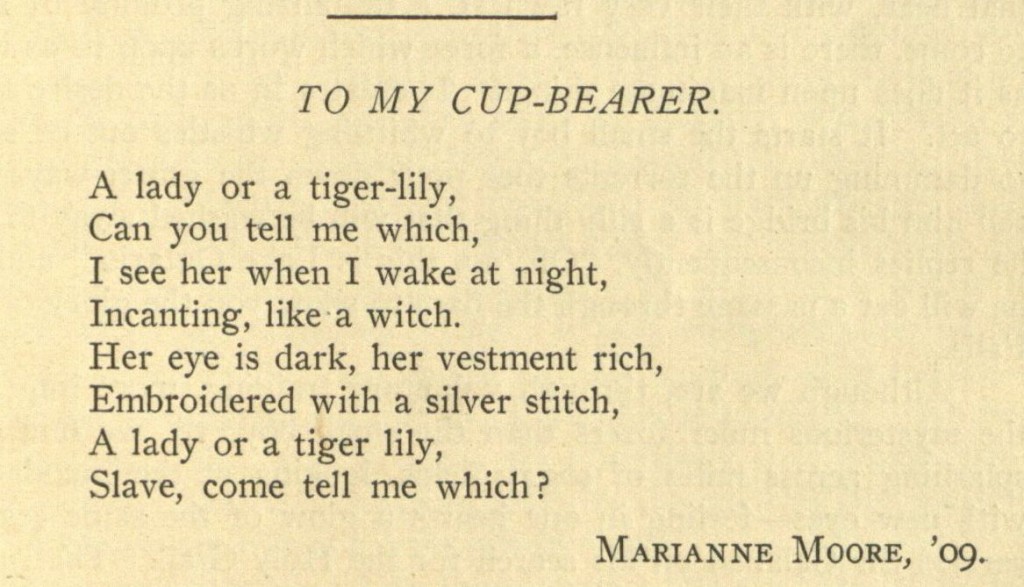To My Cup-Bearer
Friday, April 2nd, 2010 by jenrajchel
“To My Cup-Bearer”
A lady or a tiger-lily,
Can you tell me which,
I see her when I wake at night,
Incanting, like a witch.
Her eye is dark, her vestment rich,
Embroidered with a silver stitch,
Slave, come tell me which?
Marianne Moore’s early poem to “To My Cup-Bearer” interweaves tradition, feminism and access. In “To My Cupbearer” Moore archives a secret ceremony which is a Bryn Mawr Tradition. Yet, in doing so she raises raises questions about the voyeuristic inclinations of poetry . The poem itself resides in a liminal state that is not wholly revealing, yet in its publication, breeches the sacredness of the ceremony. “To My Cupbearer” creates a network of aesthetics which represent a hybrid of introspective questions and aloof images. The was poem published in 1909 the Tipyn O’ Bob along side Moore’s poem “The Sentimentalist.” The issue also published Moore’s short story, “Philip the Sober.”
In a letter to Marcet Haldeman, Moore recounts that M. Carey Thomas read aloud Moore’s poem during a Chapel speech. (“Letter to Marcet Haldeman” 1). Thomas criticized Moore’s story but praised her poem“To My Cup-bearer” and then read it aloud to the entire school. This poem represents a turning point in Moore’s career as a writer and as a student at Bryn Mawr. Through the success of this poem, Moore is publicly recognized as a writer. For Moore, struggling with her love for English but her frustration with clashing with her professors about her unique writing style, this gave her work validation. Though, Thomas criticizes Moore for her “affectation” in her short story. It is worth mentioning that Moore essays were seen as failures, whereas her poems were praised as successes. The form of poetry lends itself to gaps allowing for Moore’s nonlinearity to prosper.
It is not an accident that Thomas chooses to highlight this poem out of all Moore’s early poems. Of all Moore’s poems, “To My Cup-bearer” is permeated her Bryn Mawr experience the most. In the same letter that Moore mentions Thomas’ reaction, she also mentions the Junior-Senior Supper. Both events influence Moore enough to write to Haldeman, and as a result, the letter comes to resemble a biographical footnote. The significance of these two events to Moore’s life allow the reader of glimpse of a future Modernist poet, examining her past, present, and future, then making a conscious decision to pursue of life of poetry. We know that Moore listened to Thomas, because Moore criticized the same quality in her students when she returns to Bryn Mawr as a guest lecturer for a poetry seminar. The poem becomes an oracle for Moore’s own future and a gateway to her past.
Yet to read “To My Cup-Bearer” solely as autobiography does a disservice to the complex questions Moore interrogates. The publishing of the ceremony, in itself forces us to examine the space we are entering as readers. In Bryn Mawr College Traditions, Virginia Wolf Briscoe discusses the tradition of “the loving cup,” which is the ceremony Moore references in the poem. Information regarding the ceremony is scarce due its secrecy and its short life compared to other Bryn Mawr traditions such as “Lantern Night” and “May Day” which are still part of Bryn Mawr’s calendar today. In the short excerpt on the ceremony, Briscoe emphasizes the privacy of the ceremony and boundaries of knowledge it guards as demonstrated by her lack of specificity of the ceremony itself:
…although visitors had been welcome at the Junior Supper and entertainment for the seniors, when it came time for the presentation and sharing of the loving cup around the table among all the juniors and seniors, the visitors were asked to leave the room (567 ).
The ceremony itself demarcated the space of knowledge which was privileged. To this ceremony on the page, Moore questions to what extent poetry becomes an act of bearing. Bearing necessitates both a giver as well as a receiver– a reader as well as a creator. Moore strips the ceremony of meaning to re-infuse with epistemological questions of how knowledge should be gained. The poem layers multiple meanings to consider authority, traditions, and context. Using hyperlinks I unpack the layers through windows; this structure allows the layers not to be privileged but to remain organic to the poem.
Tags: crush, Junior-Senior Ceremony, lady, Loving Cup Ceremony, M. Carey Thomas, Marianne Moore, rich, slave, tiger-lily, witch
